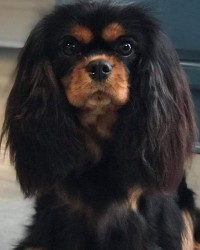History and origin: The breed name refers to Charles11 of England who was also an avid dog breeder and loved the spaniel types. During the 1900’s there was a surge to produce a flatter faced, shorter muzzled form. By the 1900’s styles changed again and there was a return to the leggier longer muzzled types that were common during Charles’ reign, this move spurred by a millionaire named Eldridge. The breed is possibly related to Cocker spaniels and Welsh springer spaniels and perhaps even Sussex spaniels. A robust and rather sporting looking dog is today’s well known type. The breed was recognized by the AK is 1996.
General Appearance: Cavaliers are sturdy toy dogs and make great family companions. Their willingness to please their owners, be they children or seniors, make them adaptable companions for homes or apartments. Known as the comforter spaniel, they have an instinctive almost innate ability to do so for their loved ones.
Coat and Colour: Coat should be of moderate length and silky, but not so long as to hinder their movement. Their long foot hair ” slippers” are a breed trait but can be trimmed for neatness. Spaying and neutering can alter the texture and colour of their hair, as will shaving. Cavaliers enjoy being brushed regularly and that will suffice to remove dead coat to lessen the growth of cavalier “dust bunnies” in your home. They come in four colours: the parti colours , blenheim (white base with deep red markings on head around ears and eyes and on the body), Tri-colour (white base with black around eyes, ears. and on the body, with tan points) ,and the whole colours, ruby ( all red ) and black and tan. Whole colours will sometimes have white toes and chest . Size: 12 to 18 pounds with slight variations in males to females. They average 12 to 13 inches at the shoulder.

Feeding: Cavaliers do well on a quality kibble, raw or home cooked diets. They are gluttons by nature however and with their large pleading eyes can easy convince their owners to provide them with more food than they need and consequently can easily carry more weight than is healthy. You will want to make sure they have things to chew on to assist in the removal of plaque and tartar on their teeth. If not, then manually brushing their teeth 3-4 times a week is a must and they are easily trained to allow this.
Training and Obedience: Cavaliers are very trainable and highly food motivated in this process. Cavaliers have a natural willingness to please. Cavaliers also enjoy agility and obedience as long as they have a patient trainer. They do well as service animals and as visiting ambassadors at nursing homes and schools. If you do not want a dog on furniture, this is not the breed for you as cavaliers thrive on being near their owners. Cavaliers are easily house trained but owners must be consistent in their training and use positive reinforcements, be it small treats or praise. Crate training is recommended as it is a must for travelling safely in the car, and when left unattended because as puppies they will tend to chew when bored.
Activity: Cavaliers are a toy breed but do require and enjoy exercise. They are not content to just sleep on a pillow ( but they will) .They are sporting in nature so will enjoy a daily walk or romp in the yard as much as they will following you around the house or enjoying an evening of Netflix
Temperament: Happy and alert, with energy levels that adapt to their surroundings and their owners. They are very trusting and stable. Not aggressive towards people or dogs.



